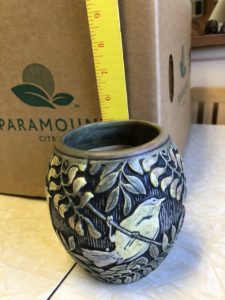 RW has a beautiful Arts and Crafts little pot made by Weller, signed on the underside WELLER, which, in 1905, was the largest pottery concern in the U.S. In business in Fultonham, Ohio, where the clay in the ground was superb. From 1872-1948, Samuel Weller made flower frogs, crocks, bowls, and pots representative of the changing decorative styles over those 76 years. Weller had a nose for fabulous artisans, many of whom signed the wares, and have now become famous and collectible in “art pottery” circles.
RW has a beautiful Arts and Crafts little pot made by Weller, signed on the underside WELLER, which, in 1905, was the largest pottery concern in the U.S. In business in Fultonham, Ohio, where the clay in the ground was superb. From 1872-1948, Samuel Weller made flower frogs, crocks, bowls, and pots representative of the changing decorative styles over those 76 years. Weller had a nose for fabulous artisans, many of whom signed the wares, and have now become famous and collectible in “art pottery” circles.
RW’s pot features a delightful blue bird on a leafy branch at just 5” tall, molded in an ovoid form. The best place to sell such a pot may be the David Rago Auction house in Lambertville NJ. David has cut a niche for himself in the ‘art pottery’ market. More about that term, later.
This design is cut out in relief and over-glazed in a high gloss, rubbed blue into the relief. The letter “F” is inscribed in the bottom. This means it’s a ‘Selma’ line Weller, significant for the William Morris style design of intertwined vines and naturalistic animalistic details of flora and fauna, executed in a linear style. The Selma line is notable for its treatment of birds, squirrels, deer, owls, and hares. The tallest of the Selma pots can sell for over $1,000.
Weller possessed a knack for seizing on a new style. He became notorious for the female figures in the Art Nouveau style. Weller’s Muskota line of 1915 featured all beautiful, long legged, round figured tumbled haired pretty nudes. All quite titillating for 1915.
The most famous of all the Weller line was the Louwelsa, from the early 20th century celebrating the horrid twilight of the Native American culture in a highly personal, romanticized format. Portraits of craggy noble faces, painted on ochres over a brown background, highly glazed can sell for $2,000 plus.
Weller, remarkably, kept up with the many changes in styles throughout the first three quarters of the 20th century. The Arts and Crafts Movement (think Craftsman wall paper styles), moving to soft realism (female nudes), to Art Nouveau (think Tiffany Jewelry with beautiful flowing locks). Then, Whimsy (think cute frogs), to the pale pastel pots, squat and handled, with semi abstract flowers of the 1920’s. Finally, his last designs, the high style of stack designs and colors, the stick figures of the Art Deco.
Throughout human history we’ve enjoyed making and using pottery. All ceramics are a chemical miracle that depends on the clay sourced. Certain areas of the world throughout history are known for the rich source of clay, and pottery centers were formed. Clay and water, fired between 600 and 1470 degrees Fahrenheit, create a vessel that cannot dissolve in its own element, water. Glazes developed over years of experimentation also permanently changed during firing. The very name “pot” comes from the Old French “potain,” meaning, “to push.” Anyone who has slapped clay around on a wheel knows how “pot” got its name.
Weller, and his method of factory art pots, represents a momentous change for the tradition of the handiwork of the potter. For centuries, pot making was divided into two categories:
- wares made for commercial use, such as sewer pipes, cooking utensils, and storage containers
- wares made as fine art
Artists in studios, sometimes large studios, going back to the Greek Red and Black wares, made artistic pots and often attributed them to individual craftsmen. Weller and those of his era developed a synthesis of the commercial and the artistic, a method coining the term “art pottery.” Individual craftsmen developed artistic, break-through designs within a commercial establishment, merging commercialism and fine art. The first two quarters of the 20th century saw the high point of ‘art pottery.”
RW’s little Weller fantasy of a pot is worth $350. These types of pots are sold to fine homeowners who love houses in the Arts and Crafts style, called the California bungalow. We have many such homes here in Santa Barbara, and pots like RW would fit right in with the enclosed, comforting, and earthy dark and sometimes hewn wood ‘natural’ Craftsmen walls. Here in town we have quite a resource for this kind of material in the State Street shop called Early California Antiques. Owner Eric Berg also sells from his warehouse in Oxnard.